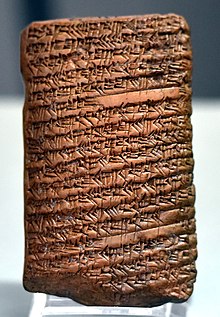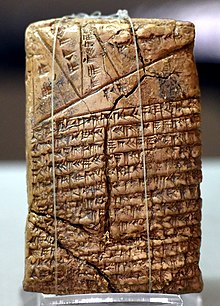Babylonian mathematics
Written in cuneiform, tablets were inscribed while the clay was moist, and baked hard in an oven or by the heat of the sun.
The majority of recovered clay tablets date from 1800 to 1600 BC, and cover topics that include fractions, algebra, quadratic and cubic equations and the Pythagorean theorem.
There has been debate over the earliest appearance of Babylonian mathematics, with historians suggesting a range of dates between the 5th and 3rd millennia BC.
[6] Babylonian mathematics was primarily written on clay tablets in cuneiform script in the Akkadian or Sumerian languages.
"Babylonian mathematics" is perhaps an unhelpful term since the earliest suggested origins date to the use of accounting devices, such as bullae and tokens, in the 5th millennium BC.
[10] Although many Babylonian tablets record exercises in multi-digit multiplication, these typically jump directly from the numbers being multiplied to their product, without showing intermediate values.
Based on this, and on certain patterns of mistakes in some of these tablets, Jens Høyrup has suggested that long multiplication was performed in such a way that each step of the calculation erased the record of previous steps, as would happen using an abacus or counting board and would not happen with written long multiplication.
The Babylonian clay tablet YBC 7289 (c. 1800–1600 BC) gives an approximation of the square root of 2 in four sexagesimal figures, 𒐕 𒌋𒌋𒐼 𒐐𒐕 𒌋 = 1;24,51,10,[13] which is accurate to about six decimal digits,[14] and is the closest possible three-place sexagesimal representation of √2: As well as arithmetical calculations, Babylonian mathematicians also developed algebraic methods of solving equations.
They knew that a solution to this form of equation is:[15] and they found square roots efficiently using division and averaging.
[16] Problems of this type included finding the dimensions of a rectangle given its area and the amount by which the length exceeds the width.
Clay tablets from c. 2000 BC include the exercise "Given an interest rate of 1/60 per month (no compounding), compute the doubling time."
Much has been written on the subject, including some speculation (perhaps anachronistic) as to whether the tablet could have served as an early trigonometrical table.
[24] The Babylonian astronomers kept detailed records of the rising and setting of stars, the motion of the planets, and the solar and lunar eclipses, all of which required familiarity with angular distances measured on the celestial sphere.
[25] They also used a form of Fourier analysis to compute an ephemeris (table of astronomical positions), which was discovered in the 1950s by Otto Neugebauer.
[26][27][28][29] To make calculations of the movements of celestial bodies, the Babylonians used basic arithmetic and a coordinate system based on the ecliptic, the part of the heavens that the sun and planets travel through.
Tablets kept in the British Museum provide evidence that the Babylonians even went so far as to have a concept of objects in an abstract mathematical space.
The Babylonians used a method for estimating the area under a curve by drawing a trapezoid underneath, a technique previously believed to have originated in 14th century Europe.

1 + 24/60 + 51/60 2 + 10/60 3 = 1.41421296... The tablet also gives an example where one side of the square is 30, and the resulting diagonal is 42 25 35 or 42.4263888...

